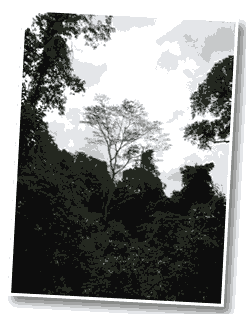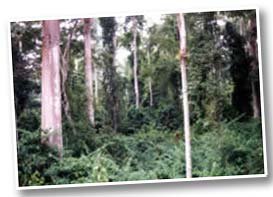

The
Research Project
The Study Area
Background Information
Tools Of The Trade
A Day In The Life Of . . .
The Study Area
Scientists have identified 25 biodiversity “hotspots” in the world. These hotspots are significant because a large number of species are found in these areas and nowhere else in the world. This is called endemisim. The Roloway monkey is an example of such a species as it is only found in West Africa.
The Upper Guinean Forest Zone is one of these 25 identified hotspots. This zone stretches from eastern Sierra Leone to Ghana. Lindsay has focused her study on two of the main forest types represented in Ghana – the moist semi-deciduous type and the wet evergreen type.
Krokosua Hills Forest Reserve
 Krokosua Hills Forest Reserve, in the north, is a moist semi-deciduous forest. This type of forest receives an annual rainfall of between 1250 mm and 1750 mm a year. (Can you convert this to inches?) The upper canopy consists of evergreen and deciduous tree species while the lower canopy consists mostly of evergreen species. The moist semi-deciduous forests contain the tallest trees, some of which can reach 50 to 60 meters in height. That is why these forests are sometimes called the “high forests”. These high forests are also less dense than the wet evergreen types.
Krokosua Hills Forest Reserve, in the north, is a moist semi-deciduous forest. This type of forest receives an annual rainfall of between 1250 mm and 1750 mm a year. (Can you convert this to inches?) The upper canopy consists of evergreen and deciduous tree species while the lower canopy consists mostly of evergreen species. The moist semi-deciduous forests contain the tallest trees, some of which can reach 50 to 60 meters in height. That is why these forests are sometimes called the “high forests”. These high forests are also less dense than the wet evergreen types.
Additionally, these forests have many emergent trees. These are trees that stand above the general canopy level. This is important because, according to one study, Roloway monkeys prefer emergent trees. The high forests are the most common in Ghana.
Ankasa Reserve
Ankasa, in the southwestern part of Ghana, is considered a wet evergreen forest. Annual precipitation is at least 1750 mm and sometimes as much as 2000 mm at certain locations. Wet evergreen forests are considered “true” rainforests. The soil is leached by the heavy rainfall and is very acidic. 
These forests are important because they are known to be the most diverse of all forest types. This means that there are more types of species here than anywhere else. However, while there may be more species represented they tend to occur in lower numbers.
The forest canopy is much lower than what is found in the moist semi-deciduous forests. Trees reach only about 40 meters in height. African mahogany, utile, sapele and makore are some of the trees found in the moist semi-deciduous forests and are important commercially. In contrast, the wet evergreen forests don’t contain very many tree species that are commercially logged.
Last Remaining Populations
Lindsay chose these two reserves because they hold the remaining populations of Roloways. Both of these reserves contain areas that are still intact pristine forest as the terrain is too difficult and/or there is too much rainfall to make logging profitable. For this reason, Lindsay has a greater chance of finding monkeys in these areas.
Continued Threat
Logging is not the only threat to the forests however. In Ghana, as in much of the rest of the world, hunting has been a part of life since the beginning of human presence. Taking what one needs from the forest is an accepted way of life for many Ghanaians. Yet as the human population increases the forests are more dramatically impacted.
Also in the past many tribes had taboos against eating certain animals. Northern Krokosua is located largely in a Sefwi region and Ankasa is located largely in an Nzema region. The Nzema people use to have a taboo against eating monkeys. However, with the migration of people in recent times this taboo is diminishing.
Officially hunting is not allowed in these areas. Unfortunately, illegal hunting continues to be a problem. Poachers, those who hunt without permission, walk the forest setting traps and snares to catch animals as food for themselves and their families as well as to sell to others. Lindsay and her guides have encountered traps and snares set by poachers and even poachers themselves more than once. The wildlife department works hard at patrolling these areas in an attempt to stop poaching.